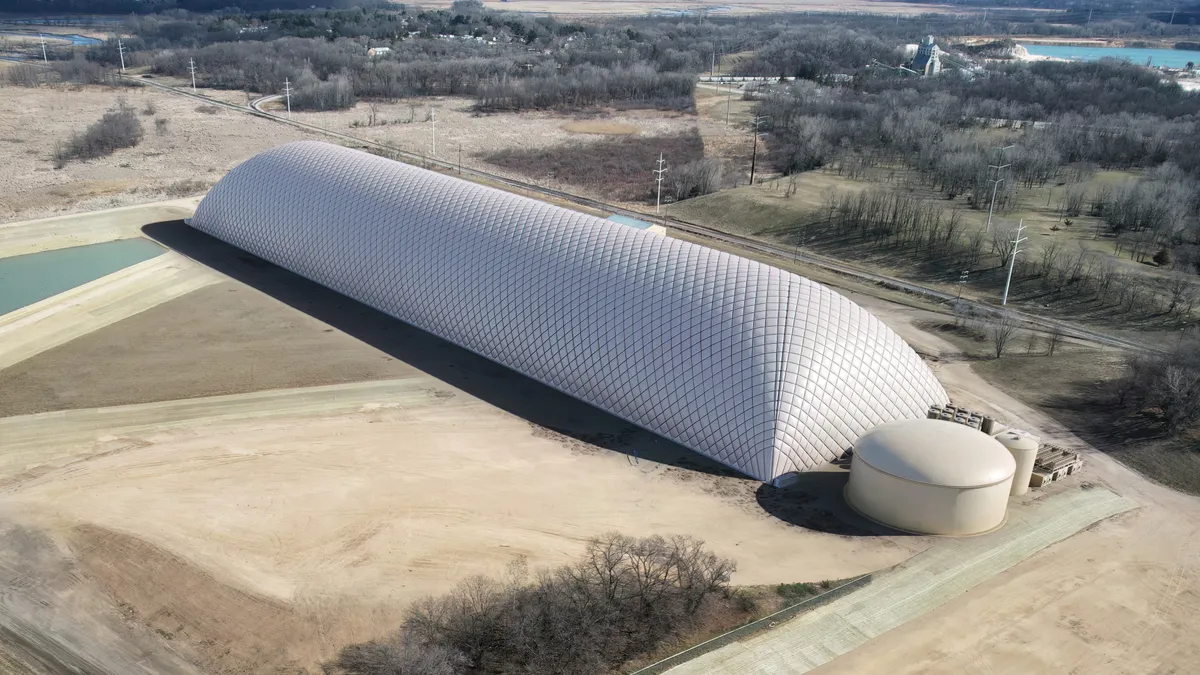Dive Brief:
-
Alliant Energy utility Wisconsin Power and Light, Madison Gas and Electric Co. and Wisconsin Public Service Corp. have requested approval from the Public Service Commission of Wisconsin to construct an up to 20-MW, carbon dioxide-based energy storage system near Portage, Wisconsin, called the Columbia Energy Storage Project.
-
The project will test a new long-duration storage concept pioneered by Italian startup Energy Dome that involves using compressed carbon dioxide to drive an otherwise conventional turbine. The company says the technology could achieve a round-trip efficiency near 75% without the need for lithium or other critical minerals.
-
The purpose of the demonstration project is to evaluate how best the new storage technology might fit within the company’s grid operations, said Mike Bremel, director of technical solutions and federal funding at Alliant Energy.
Dive Insight:
The Columbia Energy Storage Project aims to test whether CO2 could represent the fuel of the future.
Energy Dome aims to take advantage of the minimal temperature shift required to convert CO2 from a gas to a liquid and back again. Forcing the gas into a liquid state using compressors “charges” the CO2 battery, and evaporating the liquid CO2 through a turbine discharges it. The eponymous dome — which occupies most of the facility's 13-acre footprint — traps the CO2 inside a membrane that Bremel described as inflating and deflating like a balloon as the system cycles and re-uses the CO2 gas. The Energy Dome CO2 battery could run continuously on one batch of CO2 outside the occasional need for occasional maintenance, Bremel explained.
The Columbia Energy Storage Project, led by Alliant Energy in partnership with WEC Energy Group, Shell, EPRI, the University of Wisconsin-Madison and other partners, will take up to 20 MW to charge and should supply up to 18 MW of energy storage after expected efficiency losses. It will represent the first commercial-scale use of the technology in the CO2 dome technology in the U.S., though a similarly sized project is slated for completion later this year in Sardinia, Italy.
The technology quickly rose to the top of Alliant Energy's list of interesting long-duration storage ideas following a request for information the utility company put out in 2022, Bremel said. The system is based almost entirely on off-the-shelf components like compressors and turbines that are readily available, he said. It boasts a longer theoretical lifespan — potentially 30 years or more — and higher round-trip efficiency than most other long-duration energy storage proposals, he said.
The Columbia Energy Storage Project will take 10 hours to fully charge, and should be capable of supplying power for 10 hours or more. Adding a second compressor to the system — which is not currently planned for the Alliant pilot project — could enable the system to charge in as little as five hours, Bremel said.
The only reason Alliant Energy didn't spring for the proposal immediately, Bremel said, was the cost. To achieve the promised 73%-75% efficiency requires a minimum 20 MW storage system that Alliant Energy estimates would cost between $60 million and $90 million. That's more than Alliant Energy would typically spend on a pilot project, Bremel said, but a $30.7 million grant from the DOE and additional tax credits should help offset the project cost, allowing Alliant Energy to pencil in a 2026 groundbreaking pending approval by the PSC.














